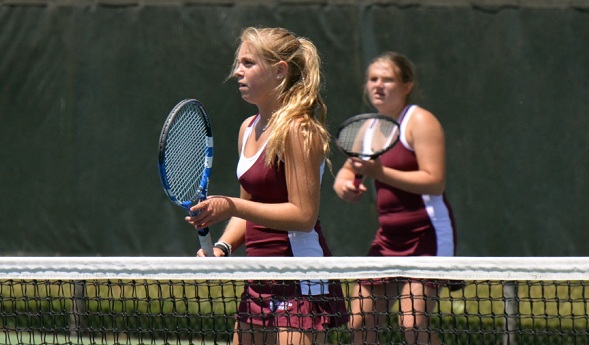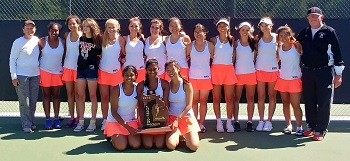
Seaholm tennis title a true team effort
June 8, 2012
By Geoff Kimmerly
Second Half editor
Birmingham Seaholm’s MHSAA Division 2 championship Saturday was the “terminus in the odyssey of our souls,” as coach Scott Ransome described it at the team’s banquet earlier this week.
In other words, it was quite a trip – punctuated by the team’s first title since 2004. And put in those words, it was a classic.
Seaholm placed seven flights into semifinals, and despite only one individual champion scored 27 points – two more than runner-up Grand Rapids Forest Hills Northern, which had won or shared the last six Division 2 titles. Seaholm finished second to FHN in 2011.
“I don't think, player for player, we were as strong as we were three years ago (when the Maples finished fourth). I thought three years ago we had the make-up, the players with the skill set (to win)," Ransome said. "But these players, whatever they lacked in skill set, they certainly made up for in desire. They were hungry.”
 The Maples receive this week’s Second Half team High 5 for how they won almost as much as winning itself. Sophomore Jackie Meier and freshman Rachel Wilson teamed to win the No. 3 doubles championship – playing to their top seed in that flight. But six other flights also played at or above their seeds.
The Maples receive this week’s Second Half team High 5 for how they won almost as much as winning itself. Sophomore Jackie Meier and freshman Rachel Wilson teamed to win the No. 3 doubles championship – playing to their top seed in that flight. But six other flights also played at or above their seeds.
It was a gratifying end to a two-month stretch that saw the Maples start with high expectations after finishing seven points behind FHN at the 2011 Final. They dominated in early competition, but then were dealt a sad blow when junior Nancy Benda – a second seed at No. 1 singles last season – was lost for seven weeks with a stress fracture.
Ransome and assistant coach Paul Young took an approach of emphasizing interchangeable parts – “We said, ‘Let's not fixate on Nancy. She’s an integral part of the program, but she in herself is not the entire program,’” Ransome told his team – and after playing a few matches defaulting at No. 1 singles, moved everyone up a flight and finished 13-1 without her in the lineup.
Meanwhile, Ransome and Young prepared their healthy players to be strong at the end. The Maples regularly do ladder drills and other agility work for 45 minutes at the start of practice before taking their first hits of the day. And the team’s No. 5 and 6 doubles teams continued to push those ahead of them to help them get stronger.
“It was almost like when Nancy returned, those girls were able to catch a breathe,” Ransome said. “They were able to get some rejuvenation in going back to their rightful positions.”
Seaholm tied with eventual MHSAA Division 1 runner-up Clarkston for the Oakland Activities Association Red championship, then finished runner-up to Bloomfield Hills Marian at the Regional. But with the benefits of season-long preparation for a final run, plus improved skills Ransome and Young saw across the lineup, the Maples had one more effort left – a championship effort, it turned out.
Sophomore Labina Petrovska advanced to the final match at No. 2 singles, as did sophomore Lauren Frazier at No. 3 and freshman Claire Markley at No. 4. Petrovska and Markley were second seeds, and Frazier was a third.
Senior Katie Root and junior Lauren Benderoff made the semifinals at No. 4 doubles as a fifth seed. And Benda won a match at No. 1 singles despite coming in unseeded.
“It was gratifying more than anything else. That’s the only way I can describe it,” Ransome said. “For what we had, for us to have enough balance in the lineup. And it really did take some help (from opponents winning other matches). We played to our seeds, and that’s what this was really all about.”

PHOTOS: (Top) Jackie Meier (center) and Rachel Wilson (right) won Birmingham Seaholm's lone individual championship, at No. 3 doubles, at Saturday's Division 2 Final. (Middle) No. 1 singles player Nancy Benda hoists the Maples' team championship trophy. (Bottom) Sophomore Lauren Frazier was one of three Seaholm singles players to advance to the final of their flights, she at No. 3 singles. (Photos courtesy of Anne Benda.)

Redemption Reigns for D1 Champions
June 2, 2018
By John Walker
Special for Second Half
MIDLAND — Bloomfield Hills junior Tia Mukherjee got redemption, while the Northville girls tennis team eked out another title Saturday at the Lower Peninsula Division 1 Finals at the Greater Midland Tennis Center.
Mukherjee dominated for a 6-0, 6-0 win over Northville senior Shanoli Kumar in the championship match at No. 1 singles. Mukherjee lost 6-0, 6-0 last year in the finals to Ann Arbor Pioneer’s Kari Miller, and said that was motivation.
“It feels great after last year,” Mukherjee said. “That was tough. I didn’t want that to happen again. I was more prepared.
“I improved my fitness and my forehand. I did a lot of off-court conditioning. I didn’t have enough energy going into the finals last year.”
Bloomfield Hills coach Chris Dobson agreed.
“Her fitness level is better,” he said. “Plus another year of maturity, poise and confidence. It makes a difference. She was highly motivated coming in.”
“At the end of the day, Tia was amazing,” Northville coach Linda Jones said.
“I thought she is the best player in the state,” Dobson said, “and she proved it. She played her best match and earned it.”
Northville had to earn its title, too, edging Midland Dow 32-30. Bloomfield Hills was third with 28 points.
The Mustangs shared last year’s title with Dow. Dow won the 2016 title. Northville won in 2015. The two were at it again in 2018.
Northville entered Saturday with 24 points and eight players in the semifinals for the first time in school history. Dow had 23 points with seven players, as did Bloomfield Hills.
Northville won key semifinals matches against Dow at No. 2 and No. 3 singles and advanced six to the finals. Dow advanced five, while Bloomfield Hills advanced three and dropped from contention.
 In the finals, Northville and Dow faced off at Nos. 1, 3 and 4 doubles. Dow got the first victory, at No. 3 doubles, and briefly tied the score with a win at No. 2 doubles. But Northville prevailed in the other head-to-head matches, clinching the crown with the win at No. 4 doubles.
In the finals, Northville and Dow faced off at Nos. 1, 3 and 4 doubles. Dow got the first victory, at No. 3 doubles, and briefly tied the score with a win at No. 2 doubles. But Northville prevailed in the other head-to-head matches, clinching the crown with the win at No. 4 doubles.
“It’s so sweet,” Northville’s Jones said. “This year we lost three important seniors and were seeded No. 2 all season behind Dow. We came in as underdogs. The girls just played over their levels. It’s the most satisfying (title). Three-time state champs is not too bad.”
“Absolutely there’s disappointment,” Dow coach Garrett Turner said, “which is a good thing, I guess. It means we’re doing the right things. We win one of those matches and the nerves are shifted to them. It’s hard to be upset with a second-place finish. We had our chances.”
At No. 2 singles, Ann Arbor Huron junior Miriam Gandam, the No. 1 seed, defeated Northville sophomore Tori Mady, the No. 2 seed, 2-6, 6-0, 6-1. Mady, the 2017 champ at No. 4 singles, got a key semifinals win over Dow’s Zoe Angell, 7-6 (3), 6-1.
At No. 3 singles, Ann Arbor Skyline senior Caroline Cartwright, the No. 2 seed, defeated Northville junior Renee Torres, the No. 4 seed, 6-3, 6-2. Torres, the returning champ at No. 3 singles, upset Dow’s Sarah Ismail, the No. 1 seed and returning champ at No. 2 singles, in a key semifinal match, 6-3, 6-4.
At. No. 4 singles, Jenna Silverman, the No. 1 seed, rallied past Dow senior Hadley Camp, 3-6, 6-4, 7-6 (1) in a 2-hour, 57-minute match. Silverman also rallied for a 4-6, 6-4, 6-2 win in the semifinals over Northville’s Maya Mulchanandani. Camp was the Finals runner-up for the third straight year.
At No. 1 doubles, Northville senior Serena Wang and junior Sophie Zhuang, the No. 1 seed, defeated Dow seniors Tatum Matthews and Kelly Livingston, the No. 2 seed, 6-1, 6-4.
At No. 2 doubles, Dow junior Meghan Killmaster and sophomore Victoria Leiti, the No. 3 seed, defeated Bloomfield Hills senior Alandria Bellamy and sophomore Kaela Bernard, the No. 4 seed, 6-2, 6-2.
At No. 3 doubles, Dow seniors Giacomina Fabiano and Christina Vanderkelen, the No. 3 seed, defeated Northville junior Madison DeYoung and freshman Michelle Tong, the No. 4 seed, 6-2, 6-3.
At No. 4 doubles, Northville junior Connie Gao and freshman Sneha Ganan, the No. 2 seed, defeated Dow juniors Amelie Kraef and Reema Patel, the No. 1 seed, 6-4, 7-6 (1). Kraef and Patel came into Saturday without losing a set all season but had to rally for a 5-7, 6-1, 7-5 win in the semifinals.
PHOTOS: (Top) Bloomfield Hills' Tia Mukherjee prepares to return a shot during her No. 1 singles match Saturday. (Middle) Northville poses with its latest MHSAA Finals trophy. (Click to see more from HighSchoolSportsScene.com.)

